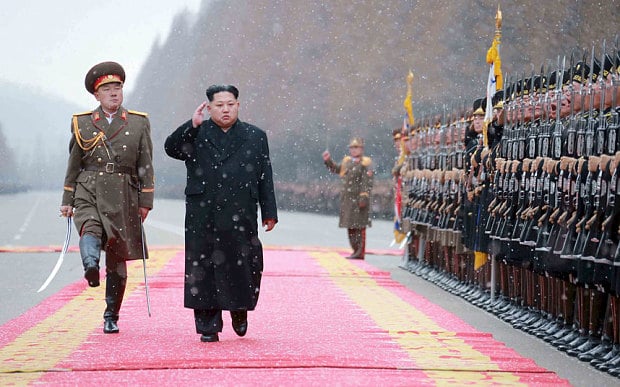In the minds of many, President Trump’s decision to use a Tomahawk missile strike against Assad’s Syrian regime last week was not only meant as a message to Assad about his use of chemical weapons, but as a message to all world leaders that the United States would take decisive action if provoked – and if there was one world leader he’d want to make sure received that message, it’s Kim Jong Un.
Kim Jong Un’s unwavering pursuit of nuclear weapons has elevated his country from the pip-squeak whose insults we ignore to a legitimate threat to the United States and its allies. North Korea’s confirmed atomic tests and successful ballistic missile launches have already demonstrated that the reclusive state has the ability to fire nuclear warheads at least as far as Japan, placing a number of U.S. military bases in South Korea and Japan squarely within their confirmed firing radius. Pictures out of North Korea also indicate that they may be rapidly approaching the development of a truly Intercontinental Ballistic Missile – one that may even be able to target the mainland United States.
Despite taking a step up in weight class, the North Korean government continues with business as usual in terms of international relations, levying threats of nuclear strikes on U.S. bases in state-owned media outlets as though a military action to limit their nuclear strike capability is already a foregone conclusion:
“Our revolutionary strong army is keenly watching every move by enemy elements with our nuclear sight focused on the U.S. invasionary bases not only in South Korea and the Pacific operation theatre but also in the U.S. mainland,” North Korea’s official Rodong Sinmun newspaper said.
It seems likely that another North Korean atomic test is imminent, as their previous testing location had appeared active in recent weeks via satellite imagery and South Korean intelligence analysts believe they may be planning the event to coincide with North Korean holidays.
“It is possible the North may wage greater provocations such as a nuclear test timed with various anniversaries including the Supreme People’s Assembly,” acting President Hwang Kyo-ahn.
Adding to tensions is a U.S. Carrier strike group led by the USS Carl Vinson, which was scheduled to begin a cruise from Singapore to Australia on Sunday but was instead ordered to turn around and head back for the Korean Peninsula.
“U.S. Pacific Command ordered the Carl Vinson Strike Group north as a prudent measure to maintain readiness and presence in the Western Pacific,” Commander Dave Benham said in a statement.
“The number one threat in the region continues to be North Korea, due to its reckless, irresponsible and destabilizing program of missile tests and pursuit of a nuclear weapons capability,” he added.
President Trump and his cabinet have not ruled out taking “kinetic action” to eliminate Kim Jong Un’s nuclear weapons program, a phrase being uttered with increasing frequency that means using direct military force. It seems likely that North Korea was a topic of conversation for the President and China’s leader in their meetings earlier this week, as he even took to Twitter to suggest that a trade deal negotiated between China and the U.S. would be “far better for them if they solved the North Korea problem”.
“If China decides to help, that would be great,” he said. “If not, we will solve the problem without them!”
Already have an account? Sign In
Two ways to continue to read this article.
Subscribe
$1.99
every 4 weeks
- Unlimited access to all articles
- Support independent journalism
- Ad-free reading experience
Subscribe Now
Recurring Monthly. Cancel Anytime.
As North Koreans prepare for their upcoming anniversary celebrations, state-owned media outlets printed a message from Syrian President Bashar al Assad congratulating them and drawing parallels between the governments.
“The friendly two countries are celebrating this anniversary and, at the same time, conducting a war against big powers’ wild ambition to subject all countries to their expansionist and dominationist policy and deprive them of their rights to self-determination,” the North’s KCNA news agency quoted the message as saying.
Assad, who has been accused of being responsible for a chemical weapons attack on civilians that killed dozens last week, many of whom were children, may not want to paint such a comparative picture between himself and the despotic leader of North Korea in the public’s mind if he wants to win over an international community that seems resolute in their assessment of the attack. As Syria and Russia work to convince the world that the U.S.’s military strike was illegal, Assad cozying up to public enemy number one in North Korea certainly won’t help their cause.
Image courtesy of Reuters











COMMENTS
You must become a subscriber or login to view or post comments on this article.